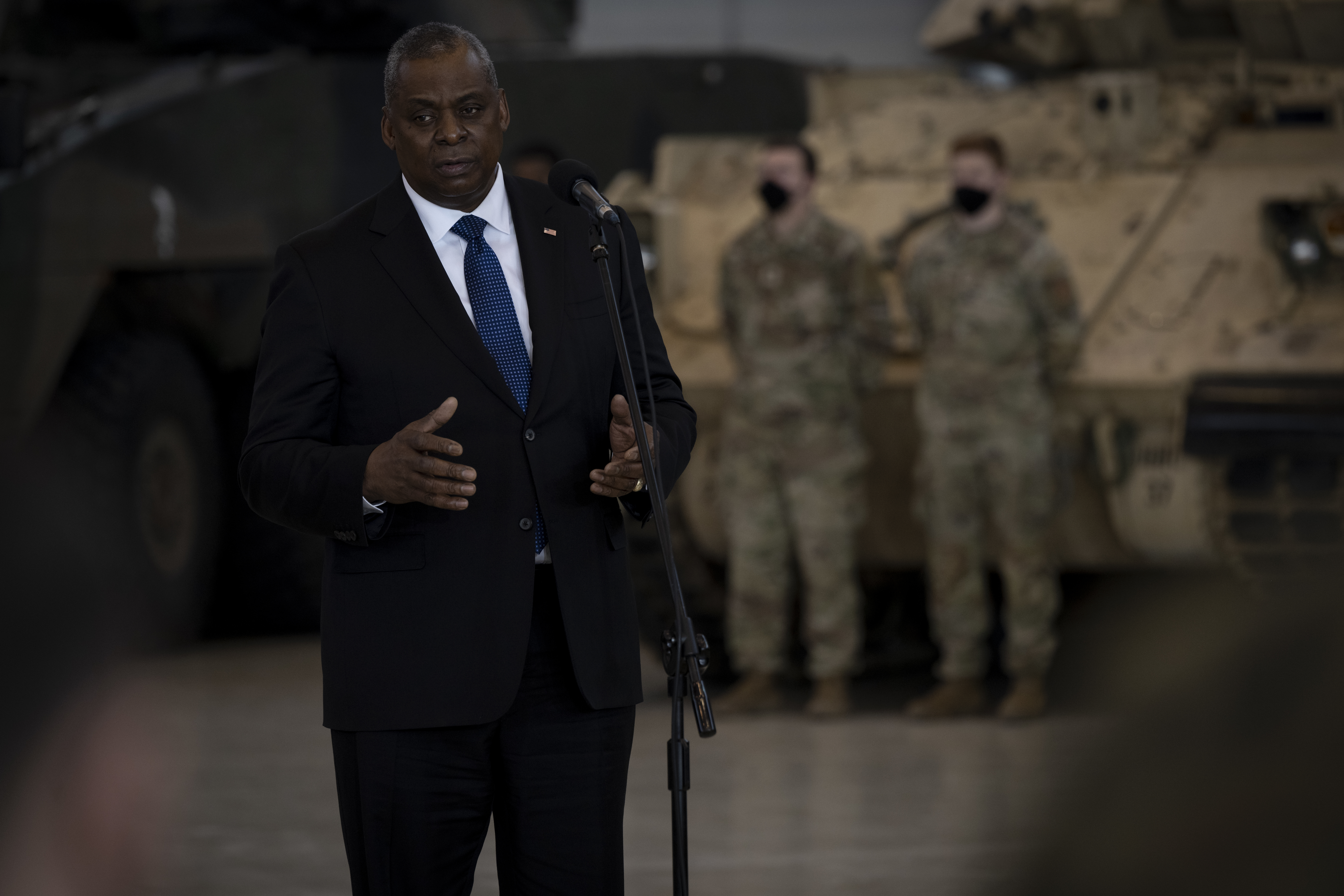Defense Secretary Lloyd J. Austin III spoke to his Russian counterpart by phone and visited Poland, the largest recipient of American troops and air combat power on the eastern flank of NATO, on Feb. 18 as administration officials indicated Russia now has 190,000 troops on Ukraine’s border.
Austin called for de-escalation, a return of Russian forces to their home bases, and a diplomatic resolution in his call with Russian Minister of Defense Sergey Shoigu, according to a DOD statement. In public remarks, Austin also announced approval of a foreign military sale of 250 Abrams Main Battle tanks and other defense equipment to Poland at a cost of $6 billion to shore up the eastern flank.
“We will do what’s necessary to help defend our partners and allies,” Austin said alongside his Polish counterpart in Warsaw before visiting U.S. troops at the Powidz Air Base. Austin is expected to travel to the Baltic nation of Lithuania next before returning to Washington.
The U.S. Air Force recently deployed 16 F-15 fighter jets to Lask Air Base, Poland, from the 336th Fighter Squadron, 4th Fighter Wing, at Seymour Johnson Air Force Base, N.C., and the 48th Fighter Wing at RAF Lakenheath, U.K. The U.S. also has sent an estimated 4,700 troops from the Army’s 82nd Airborne Division to Poland to augment a standing force of some 4,000, part of the Army’s V Corps, which is headquartered in Poznan, Poland.
Polish Defense Minister Mariusz Blaszczak called the American combat power “the biggest and the most important deterrent factor” against Russia.
“We are dealing with an attempt to rebuild the Russian empire by Putin,” the Polish defense minister said, citing Russia’s invasion of Georgia in 2008 and annexation of Crimea in 2014. “The security of Poland means the security of the entire eastern flank of NATO.”
Blaszczak said American support bolstered interoperability and lifted Poland’s plans to modernize its forces, including with the planned purchase of F-35 fighter aircraft. A sale of 32 F-35s for $6.5 billion was approved in 2019, but Poland has yet to complete the purchase. Poland’s Air Force currently consists of F-16C, F-16D, and C-130 aircraft.
The Russian Threat to NATO
Polish security analyst Wojciech Lorenz of the Polish Institute of International Affairs in Warsaw believes Russia’s troop positioning so close to NATO borders warrants the increase in U.S. and NATO forces on the eastern flank.
“If Russia invades Ukraine, it can quickly also change its force posture along the borders of NATO and EU member states. It can threaten NATO,” Lorenz explained to Air Force Magazine by phone from Warsaw.
“Poland would be the first line of defense against a potential Russian attack,” he added, describing how wealthier NATO partners have divested from heavy equipment such as tanks. “The overall strategic picture has deteriorated so significantly, that we don’t have too much time.”
The analyst said Russia seeks to divide NATO with the threat of conflict in the east, hoping to inflict economic harm with the insecurity caused by a sustained troop buildup. The European Union on Feb. 11 approved a $1.4 billion aid package to Ukraine to prevent collapse in the face of Russian pressure.
“By increasing the risk that there will be the conflict between NATO and Russia, it could hope to influence the decisions in numerous NATO member states regarding Russia’s demands,” Lorenz said.
In December, Russian President Vladimir Putin sent NATO a draft treaty that included barring new members from joining the alliance and pulling back NATO and U.S. forces from the most recent member states on the eastern flank. NATO’s January response to Russia included a proposal to discuss arms controls, missile defense, and military transparency. Russia’s 11-page answer, which President Joe Biden indicated he had received Feb. 16, has not been made public.
Even a prolonged Russian presence in Belarus of a month or more is possible, Belarusian leader Alexander Lukashenko alluded to in comments Feb. 17 before traveling to meet Putin in Moscow.
Meanwhile, U.S. officials have called out Russia for building up its troop, hardware, and logistics capabilities while claiming in recent days to pull back from the border. The U.S. now estimates Russia has between 169,000 and 190,000 troops on Ukraine’s borders.
Austin’s show of support for the largest Eastern European NATO ally also comes as Russia appears to be preparing “false flag” scenarios that would give it a casus belli to invade Ukraine.
In recent days, heavy shelling has taken place in the Donbas region of eastern Ukraine, with the leader of the breakaway Donetsk region calling for a mass evacuation of ethnic Russians across the Ukrainian border into Russia.
Speaking to the UN Security Council Feb. 17, Secretary of State Antony Blinken warned that U.S. intelligence had unearthed a variety of potential Russian plots.
“Russia plans to manufacture a pretext for its attack,” Blinken said. “This could be a violent event that Russia will blame on Ukraine, or an outrageous accusation that Russia will level against the Ukrainian Government.”
The list of scenarios included a “terrorist” bombing, the discovery of a mass grave, a staged drone strike against civilians, or a chemical weapons attack labeled as ethnic cleansing or genocide.
“In the past few days, Russian media has already begun to spread some of these false alarms and claims, to maximize public outrage, to lay the groundwork for an invented justification for war,” said Blinken, who is scheduled to meet Ukrainian President Volodymyr Zelensky along with Vice President Kamala Harris at the Munich Security Conference Feb. 19.
Already, the regular use of declassified U.S. intelligence to preempt a Russian false flag operation has led some commentators to question if the U.S. is overhyping Russian intentions.
“It has some limitations,” said Lorenz. “After three or four times, it gets less and less credible.”
